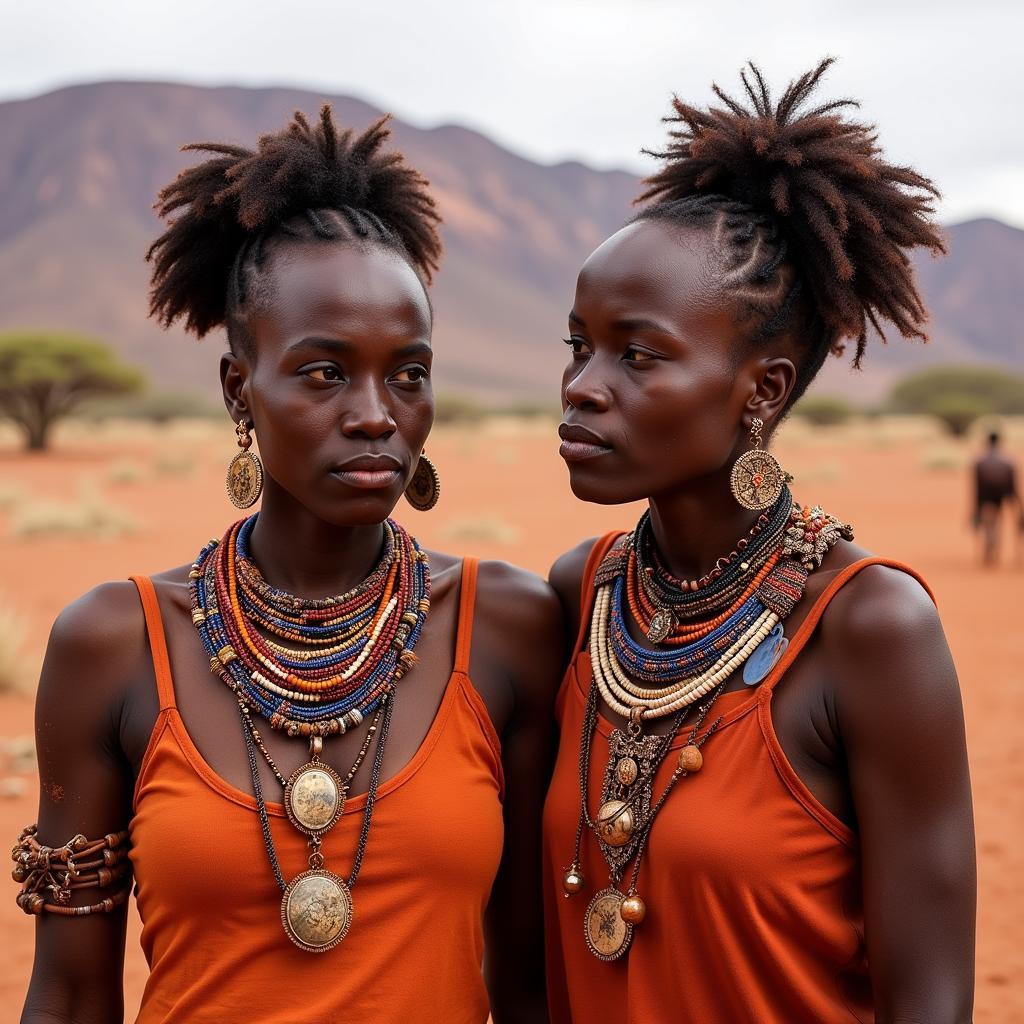Exploring Traditional African Garb
Traditional African Garb is more than just clothing; it’s a vibrant tapestry woven with history, culture, and artistry. Each garment tells a story, reflecting the diverse traditions, social status, and environmental influences of the wearer’s community. From the intricate patterns of Kente cloth to the flowing robes of the desert nomads, traditional African garb offers a glimpse into the rich heritage of the continent. This article delves into the fascinating world of traditional African attire, exploring its diverse forms, meanings, and significance in contemporary society.
African clothing styles vary significantly across the continent’s 54 countries, each boasting unique designs, fabrics, and embellishments. These garments often incorporate symbolic patterns, colours, and materials that reflect local beliefs, customs, and traditions. For example, certain colours may signify royalty, while specific patterns might represent clan affiliations or spiritual beliefs. The materials used also hold significance. Everything from handwoven cotton to animal hides reflects the resources available and the ingenuity of the artisans. Learn more about the meaning behind different prints in this article about African clothing and prints meaning.
The Significance of Traditional Garb in African Culture
Traditional African garb plays a crucial role in various cultural ceremonies, festivals, and rituals. Weddings, funerals, and coming-of-age celebrations are often marked by specific attire that signifies the importance of the occasion. These garments serve as a powerful visual representation of cultural identity, connecting individuals to their ancestors and reinforcing community bonds. Moreover, the creation and wearing of traditional garb often involve intricate craftsmanship and specialized knowledge passed down through generations, contributing to the preservation of cultural heritage. For those interested in learning more about general African dress codes, visit African dress code.
What are the different types of traditional African garb?
Traditional African garb encompasses a wide range of clothing styles, from the brightly coloured dashikis of West Africa to the intricately beaded garments of the Maasai people in East Africa. Each region and ethnic group has its own unique style, reflecting its history, environment, and cultural values. The use of specific fabrics, colours, and embellishments further distinguishes these garments, adding layers of meaning and symbolism. Explore the rich diversity of African fashion and discover the stories behind each unique style. If you are interested in purchasing authentic African attire, you might find this helpful: African boutique in Atlanta.
Traditional African Garb in the Modern World
While modern fashion trends influence clothing choices across Africa, traditional garb continues to hold a special place in many communities. It is often worn during special occasions, festivals, and cultural events, serving as a symbol of pride and heritage. Many contemporary African designers are also incorporating elements of traditional garb into their creations, giving rise to innovative and exciting new styles that blend tradition with modernity. This fusion of old and new celebrates African heritage while embracing contemporary aesthetics.
How is traditional African garb made?
The creation of traditional African garb often involves intricate techniques passed down through generations. From weaving and dyeing to beadwork and embroidery, each step requires skill and precision. The materials used, such as cotton, silk, leather, and raffia, are often locally sourced and processed using traditional methods. The process of creating these garments is not just about making clothes; it’s about preserving cultural heritage and artistic traditions. For comfortable and stylish African dance pants, see African dance pants.
Conclusion
Traditional African garb is a powerful expression of cultural identity, reflecting the rich history, artistry, and traditions of the continent’s diverse communities. From ceremonial robes to everyday attire, these garments tell stories, connect generations, and preserve cultural heritage. As we continue to explore and appreciate the beauty and significance of traditional African garb, we gain a deeper understanding of the vibrant tapestry of African culture.
FAQ
-
What is the most common type of traditional African garb? The answer depends on the region, but widely recognized garments include the dashiki, kente cloth, and various styles of robes and wraps.
-
Where can I buy authentic traditional African garb? You can find authentic pieces at African markets, specialized boutiques, and online stores. Be sure to research the seller to ensure authenticity.
-
How do I care for traditional African garb? Care instructions vary depending on the fabric and embellishments. Always check the garment’s label or consult with a specialist.
-
Can I wear traditional African garb even if I am not African? Absolutely! Appreciating and respectfully wearing other cultures’ clothing is a great way to learn and connect. However, be mindful of cultural significance and avoid wearing garments meant for specific ceremonies.
-
What is the significance of colours in traditional African garb? Colours often hold symbolic meaning, representing everything from royalty and status to spirituality and nature.
-
Are there any modern adaptations of traditional African garb? Yes, many contemporary designers incorporate elements of traditional garb into their creations, blending tradition with modern aesthetics.
-
Where can I learn more about the history of traditional African garb? Museums, cultural centers, and online resources offer a wealth of information on the history and significance of African clothing.
Have you seen an African man picture showcasing traditional garb?
For further assistance, please contact us at Phone: +255768904061, Email: kaka.mag@gmail.com or visit us at Mbarali DC Mawindi, Kangaga, Tanzania. We have a 24/7 customer service team available to assist you.

